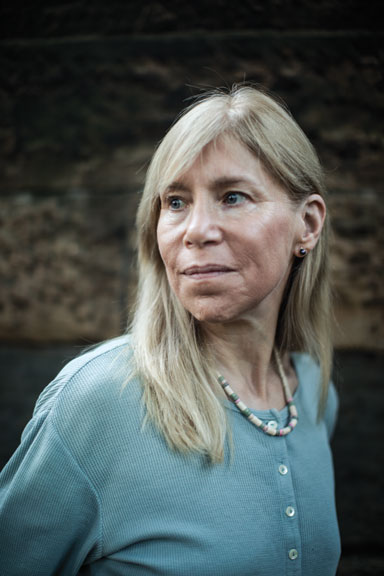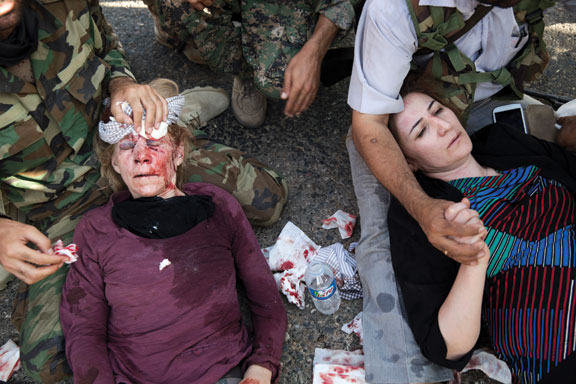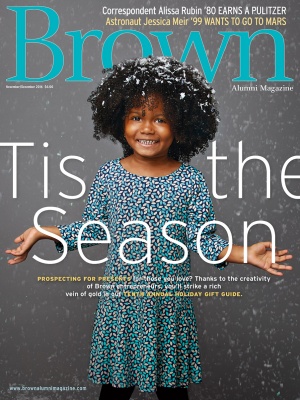When you first delve into a dispatch by New York Times journalist Alissa Rubin ’80 from one of the world’s trouble zones, you might feel as if you’re reading a short story. That’s how vividly she portrays the characters and settings.

In “How Baida Wanted to Die,” which appeared in the August 16, 2009, New York Times Magazine, she introduced readers to a woman who’d enlisted as a suicide bomber in Iraq. “You will like Baida,” an Iraqi police investigator tells Rubin at the beginning of the story. She writes: “It was a curious thing to say about someone who sought to kill people like him and like me. He added, almost pensively: ‘I like Baida. She is’—he paused—‘honest.’”
There has been an endless flow of political and military-themed accounts from Iraq and Afghanistan in recent years, but Rubin’s best work is that rare thing: stories of often ordinary people leading lives in cultures that limit their opportunities and freedoms. Her deeply reported and gracefully literate reports have earned her the John Chancellor Award for excellence in journalism; the Michael Kelly Award, which honors “journalists whose work exemplifies the fearless pursuit and expression of truth”; and the Overseas Press Club’s Ed Cunningham Award.
And Rubin, now the Times’s Paris bureau chief, won the Pulitzer Prize in international journalism this year for a series of five stories that the jury described as “thoroughly reported and movingly written accounts giving voice to Afghan women who were forced to endure unspeakable cruelties.” One story focused on Parveena, a policewoman in remote eastern Afghanistan who embodied the difficulties faced by female law enforcement officers in the country; she was shot to death a month after Rubin interviewed her. Another told the horrifying tale of Farkhunda, a deeply religious woman who was killed by an enraged mob on viral video after being falsely accused of burning a Quran. In Rubin’s skillful telling, Farkhunda’s death and its aftermath revealed the larger challenges of creating a functioning justice system in a country with no history of Western-style jurisprudence.
“Rubin has spent much of her distinguished career in battlegrounds, whether Iraq, Afghanistan or the Balkans,” the Times’s editors wrote in support of her Pulitzer entry. “What marks her coverage is her courageous and sensitive portrayal of how war deforms societies.… ‘I always try to imagine myself as both a victim and a perpetrator,’ she said, ‘and then ask people questions to help me see the world from their point of view.’”
According to Times executive editor Dean Baquet, what makes Rubin’s work extraordinary is the combination of her deep empathy with the people she interviews and her distinctly literary world view. “I think she sees conflict as part of a larger human narrative,” Baquet says. “I think she sees the world like a writer.”
In explaining these far-off lands to readers who may well have tuned out years ago, Rubin herself says she’s simply aiming to write articles that illuminate what’s happening and why. “I’m trying to tell you the story of now, in that place,” she says. She was drawn to Baida’s story, for example, because female suicide bombers were becoming more common. There had been sixty or so such bombings or attempts, mostly between 2007 and 2008, according to statistics cited in the story.
“Each woman’s story is unique,” Rubin writes in “How Baida Wanted to Die,” “but their journeys to jihad do have some commonalities. Many have lost close male relatives.… Many of the women live in isolated communities dominated by extremists, where radical understandings of Islam are the norm. In such places, women are often powerless to control much about their lives; they cannot choose whom they marry, how many children to have or whether they can go to school beyond the primary years. Becoming a suicide bomber is a choice of sorts that gives some women the sense of being special, with a distinguished destiny. But Major Hosham [the same official who’d predicted that Rubin would like her story’s main subject] urged me not to generalize: ‘All the cases are different. Some are old; some are young; some are just criminals; some are believers. They have different reasons.’”
In the story of Parveena’s violent death, Rubin writes of the naïveté underlying many Western efforts to help women in Afghanistan: “The plight of women under the Taliban captured the Western imagination, and their liberation became a rallying cry. A flood of money and programs poured into Afghanistan, for girls’ schools and women’s shelters and television shows, all aimed at elevating women’s status. But these good intentions often foundered against the strength of Afghan sexual conservatism. As the tale of Afghan policewomen shows, repressive views of women were not just a Taliban curse, but also a deeply embedded part of society.”
Occasionally Rubin aims her searching gaze at herself. In 2011 she wrote about donning her “first Afghan burqa” for safety while traveling from cosmopolitan Kabul through a Taliban-controlled area near the location where her former Times colleague David Rohde ’90 had been abducted in 2008. Rubin describes the mundane details of burqa fashion— the colors, the fabric, the cost. But she also recounts the panicky feeling when she couldn’t immediately locate the mesh that helps conceal the wearer’s eyes, and muses about the effect concealing herself had on her mental state.
Obscuring her face for the dangerous drive, Rubin “felt rejected with my burqa down, as if I were not good enough to be seen in public. I leaned back in the seat and felt a wash of passivity come over me. Nothing was demanded of me except silence,” she wrote, even as she noted that covering up is a local woman’s ticket to “getting out of the house” without the risk of being deemed a “seductress.”
Rubin was forced to dictate another first-person account from a hospital bed in Istanbul. On Tuesday, August 12, 2014, Rubin was aboard a helicopter covering a humanitarian mission to bring food and other supplies to Yazidis who had fled Islamic state terror to Mount Sinjar in northwestern Iraq. When the helicopter arrived, men, women, and children scrambled on board, overloading the aircraft for its return trip and eventually causing it to crash. Rubin sustained two broken wrists and a fractured skull.
“If it weren’t for Tuesday’s helicopter crash on Mount Sinjar,” she wrote, “what would I have written about the plight of the Yazidis? I would have started, I guess, with this mountain that everybody is talking about, to which the Yazidis have fled. It’s hard to overstate the size of this mountain, which is such a sacred place to the Yazidis, and the place they went to escape the terror that the Islamic State in Iraq and Syria has been inflicting on them.
“Then I would have written about our pilot, Maj. Gen. Majid Ahmed Saadi, a veteran Iraqi Arab officer helping the Kurds rescue the Yazidis.” The general, who was in charge of training for the country’s air force, was a deeply moral person who told her this volunteer mission was the most significant in his thirty-five years of flying.
Instead, Rubin wound up recounting the circumstances that led to the accident, and her own rescue by a second helicopter: “Several people picked me up and carried me aboard in a very inexpert fashion; that really hurt, unfortunately. I heard myself groan like everybody else. At that moment, it just hurt so much. But then I thought, that’s good. At least I’m alive.
“I bet a lot of them are not.
“How is the pilot? Did he make it? He just wanted to help.”
Only later did she learn that he was the only person not to survive the crash.
Rubin, who has a master’s degree in history from Columbia and who once considered life as an academic, took a circuitous path to a career as a foreign correspondent. In retrospect, though, she thinks that, from early on, it was meant to be. At Brown she concentrated in Renaissance studies and studied classics. She was particularly drawn to the Greeks, who wrote about themes that transcended time and culture. Looking back, she sees definite connections between the things she’s witnessed and how Achilles loses his moorings when a close friend is killed in The Iliad, or Antigone’s focus on what happens after death. Antigone, she says, “is a play about the need to go through burial rites. Think of all the wars in which people have wanted to find their children and bury them.”
Rubin’s Brown education wasn’t exactly preparation for her later life, she says, “but if you believe that there is some value to having the Western canon as a framework, it was enormously useful.” On a more practical level, her experience as a manager at the Ivy Room and the campus co-op came in handy when she managed overseas bureaus. That experience also almost led to a job at General Mills. If things had gone differently, Rubin jokes, she could have ended up selling Lucky Charms.
Her first newspaper job after graduation was at the Wichita Eagle. For a young reporter who had grown up in New York City, this plunge into the heart of America might as well have been a foreign assignment. “I’d never driven anywhere” before moving to Kansas, she says. “I’d never been to a McDonald’s.”
At the Eagle she covered everything from wheat farming to fast-food franchises. She grew to love it there, and learned something about immersing herself in unfamiliar cultures. Rubin later went to Louisiana on an Alicia Patterson fellowship to write about abortion after the U.S. Supreme Court’s 1989 decision Webster v. Reproductive Health Services. She then moved to Washington, D.C., where she wrote for Congressional Quarterly and the Los Angeles Times.
Rubin’s big break came in early 2001, when the Los Angeles Times sent her to Vienna. Her beat included the Balkans. Baquet, who was then that paper’s managing editor, says the idea was to have Rubin broaden out, to have her write global stories about health and the environment rather than simply zero in on conflict and geopolitical maneuvering, as is the habit for most foreign correspondents. The world was at relative peace, he recalls, and “I thought we were creating a different type of foreign correspondent.”
Then came the September 11 attacks, and all that changed. Rubin volunteered to join the second wave of journalists to flood the region, in part, she says, because she was struggling so hard to understand what had happened on a personal level, and stayed on to cover American involvement in Afghanistan and Iraq. Rubin left the Los Angeles Times in 2007 for the New York Times, where she became a correspondent based in Baghdad and later the bureau chief. In 2009 she was appointed bureau chief in Kabul, where she remained until 2013.
Running these bureaus presented a new set of challenges. In Baghdad, she oversaw the Times reporting staff as well as a sprawling network of local employees. She had to make sure she didn’t send Sunni translators into Shiite areas. To cover stories in areas too dangerous for Western reporters, she dispatched Iraqi stringers, and it was then Rubin’s responsibility to make sure their accounts met the Times’s exacting paper-of-record standards.
“You feel responsible, but you also feel terrified that you’ll miss something,” she says, “or that you’ll not be in the position to cover something. Both are terrifying.” She and her U.S. reporters were “very, very dependent on the honesty of translators,” who were generally dedicated and scrupulous, she says. Ensuring the safety of local staff as well as foreign journalists was always paramount. In Baghdad, journalists traveled with translators and guards and went everywhere with two cars; that way, if something happened to one car everyone could pile into the second and escape. In Afghanistan, she says, journalists were free to move around Kabul without guards but had to be vigilant in remote areas. “You can’t tell a story if someone gets kidnapped or shot,” she says. “Every trip someone takes, you worry until they come back, even if it’s a really short trip.”
In Baghdad Rubin wore a hijab that covered her blond hair but left her blue eyes exposed. In Kabul, she wore local clothing and a veil, and mimicked how women around her carried themselves and walked in the open-backed mules they often wore.

Despite the risks, Rubin traveled extensively. Campbell Robertson, a Times reporter who worked in the Baghdad bureau and who is now a national correspondent based in New Orleans, knew of Rubin by reputation when he arrived in Iraq as someone “who would go places where nobody else had the guts to go.” Eventually, he says, he got to know her as a coworker and boss who was generous with advice, sources, and story ideas. Rubin, he says, is equipped with an intellectualism and sensitivity that’s “very unusual in this traditionally macho world”—and who is someone he could just as easily envision teaching literature somewhere.
One day, while still working for the Los Angeles Times, Rubin was at a Fallujah hospital reporting a story about civilians killed by Americans. When a relative of one civilian entered the hospital, he spotted Rubin and her translator.
“He didn’t want foreigners there,” she recalls. “He particularly didn’t want Americans there. He pulled out a gun and waved it in my face and my translator’s face. He was very, very close to both of us.”
The grieving man tried to take a notebook from the translator, who gave him some pages, and as Rubin and the translator walked out, the people who had gathered, including the health care workers the pair had been interviewing moments before, watched silently. “At every step,” Rubin says, “we felt like we might get shot in the back. They were silent. You just didn’t know.”
Her most harrowing experience, though, was the 2014 crash. Rubin was among the most seriously injured survivors, and she faced a difficult recovery, including cognitive therapy, physical therapy, and multiple surgeries. Subcranial bleeding had injured her brain, forcing her to learn to read all over again. She could still recognize words, but she had trouble retaining them and quickly tired and became nauseous. So she trained herself to make lists and rest her brain, and worked her way up to harder material by reading children’s books, including the Harry Potter series. For someone who devours poetry and regrets never having learned Greek so that she could read The Iliad in its original form, “this was the most frightening part of it. Reading is how I do my job, and it’s one of my greatest pleasures.”
Rubin went back to work, but says it took more than a year and half before she felt entirely like her old self. The first time she remembers not feeling the aftereffect of the accident was when she covered the Brussels bombings that killed more than thirty people in March of this year.
The assignment as Paris bureau chief, says Baquet, was meant to be something of a break, a reward even, for all those years of hard duty in danger zones. It was also a chance to get back to the original concept that the two had discussed all those years ago of a foreign correspondent as something more than a conflict correspondent. Rubin, who lives in Paris with her husband, lawyer James Castello, began reporting stories on Syrian refugee chefs and a Musée Marmottan Monet exhibit focusing on images of bathers.
But the terrorist attacks in Paris and Nice this year have made the skills Rubin learned in Baghdad and Kabul more relevant than ever. “It wasn’t my intent,” Baquet notes, “but it makes her very qualified to cover Paris.”
Rubin’s new beat also includes immigration and how demographic changes resulting from it will affect France’s strong sense of identity. Five years after chronicling her own first experience wearing a burqa, Rubin filed a story on bikinis, burkinis, and the age-old yet newly touchy debate over regulating what women wear. (Burkinis is the popular name for bathing suits devout Muslim women are allowed to wear to the beach; some French municipalities have banned them.)
Even after the Paris move, Rubin returned to Afghanistan to complete the Pulitzer-winning series on women there. Baquet says it’s a story she’d wanted to tell for years. Not only did she feel a deep connection with women trying to survive, let alone thrive, in difficult circumstances, he said; she also saw it as a way to chronicle the failure of U.S. involvement in the country to create real and lasting change.
This was supposed to be a “good war,” Baquet notes, one that would change Afghan society for the better. In the end, he said, Rubin’s stories were so powerful because they chronicled “the failure of America to keep its promise—and also how hard that promise was to keep.”
Contributing editor Stephanie Grace is a political columnist for the New Orleans Advocate.





